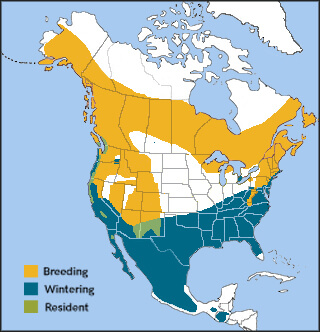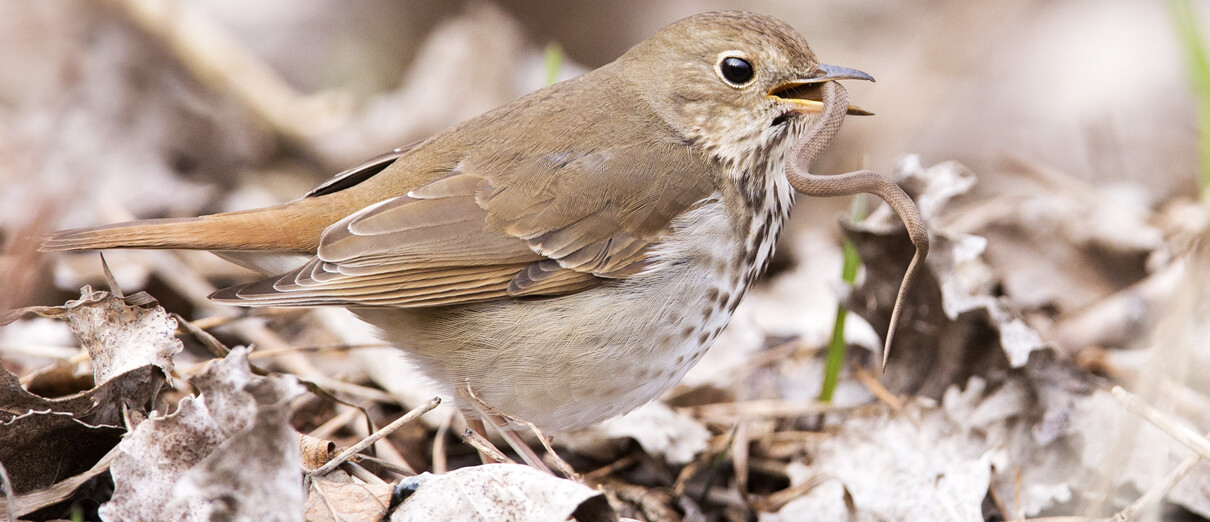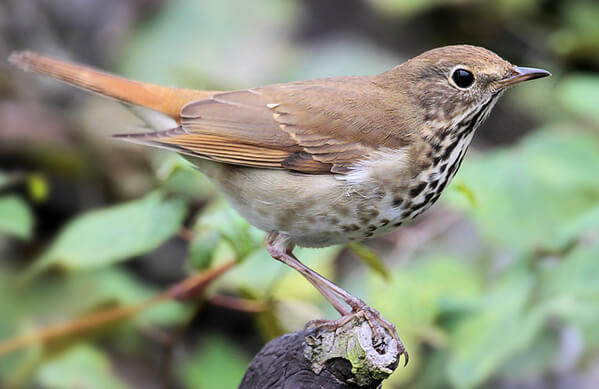
Hermit Thrush range map by American Bird Conservancy
Aptly named for its retiring ways, the Hermit Thrush is a bird of dense forest understory and thicket that is often heard before it's seen. A quick glimpse reveals a brown-backed, spot-breasted thrush a bit smaller than an American Robin, with a reddish-brown rump and tail. While its species name guttatus is Latin for "spotted," the Hermit Thrush's breast spotting is not as bold nor extensive as that of the Wood Thrush.
A Telltale Tail
The Hermit Thrush can often be identified in the field by its regular habit of quickly raising and slowly lowering its reddish tail. It also flicks its wings when perched, although not as continuously as a Ruby-crowned Kinglet. Other thrushes may raise their tails or flick their wings, but not with regularity.
The Hermit Thrush is more cold-tolerant than the related Swainson's and Bicknell's Thrushes, and is the only spot-breasted thrush likely to be seen in the United States during the winter. With the exception of West Coast birds up to southern British Columbia, most Hermit Thrushes winter in the southern part of the United States, or in Mexico, with some reaching as far south as Guatemala.
A Slew of Subspecies
The Hermit Thrush is one of North America's most widely distributed forest-nesting migratory birds. The species is highly variable across its extensive breeding range, with 12 subspecies recognized. These subspecies are further divided into three groups: the small, brown Pacific coastal group; the large, grayish birds of the Mountain West; and the more rufous eastern group.
Silvery-voiced Singer
The Hermit Thrush's song begins with a single clear whistle, leading into a melodious, flute-like warble so lovely that this bird is often called the "American Nightingale." Its call, commonly heard in winter and while the bird is foraging, is a low chup; also listen for a shrill alarm call of rheee.
"The cast of its song is very much like that of the Wood Thrush," observed American naturalist and writer John Burroughs, "and a good observer might easily confound the two. But hear them together and the difference is quite marked: the song of the Hermit [Thrush] is in a higher key, and is more wild and ethereal. His instrument is a silver horn which he winds in the most solitary places."
Listen to the Hermit Thrush's ethereal song below:
A Changing Diet
Hermit Thrushes switch diets according to the season. In spring, they eat mostly insects like bees, wasps, flies, and caterpillars, or even the occasional small amphibian or reptile. During the winter, they mainly subsist on fruits, especially berries, in the manner of another cold-hardy migrant, the Yellow-rumped Warbler.
Like the White-throated Sparrow or Spotted Towhee, the Hermit Thrush does most of its foraging on the ground, using its bill to flip over leaves and other groundcover as it hops about. It will also forage low in shrubs and trees.

Hermit Thrush eating a small snake by Mircea Cotina/Shutterstock
Going to Ground
Male Hermit Thrushes return to breeding areas in early spring, staking out and defending a territory through song, in hopes of attracting a female. Once mated, the female Hermit Thrush builds a bulky, cup-shaped nest of grasses, leaves, and other natural materials on the ground. The nest is usually in a natural depression and concealed under overhanging vegetation, rocks, or root masses. In the West, Hermit Thrushes often nest in trees, but still near the ground.
The female incubates the clutch of three to six bluish-turquoise eggs herself. Once they've hatched, the male joins in feeding the nestlings. Hermit Thrushes can raise several broods in a breeding season if nesting conditions are ideal. Like other ground-nesting birds such as Hooded and Kirtland's Warblers, Hermit Thrushes are often unwitting hosts to Brown-headed Cowbird chicks.
Thriving Thrush
Breeding Bird Survey and Christmas Count data reveal that Hermit Thrush populations have remained stable or increased over the past few decades. The Hermit is the only forest thrush species showing this positive trend, likely because this species tolerates a certain amount of human disturbance in its habitats. Its breeding productivity, however, often dips in fragmented forests. Climate change is expected to impact the Hermit Thrush, likely shrinking its range in the summer, expanding its range in winter, and creating an overall population shift northward.
Hermit Thrushes are nocturnal migrants, and so are frequent victims of collisions with glass, towers, and wind turbines. ABC's Glass Collisions program offers solutions to keep migrating birds from hitting windows.
Donate to support ABC's conservation mission!



















































